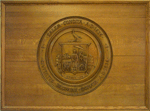Rogers, John
John Rogers(1829–1904), was a sculptor from Salem, Massachusetts, noted for small statuettes. Popularly termed "Rogers Groups", these figurines were mass-produced in cast plaster.
Rogers was born Oct. 30, 1829 in the house of his grandfather, the Pickman-Derby mansion, demolished in 1915, to make way for the Masonic Temple.
After working as a machinist and draftsman in New Hampshire, he studied art in Paris and Rome from 1858-59. He set up a studio in New Canaan, Connecticut in 1878.
His studio at The New Canaan Historical Society, 13 Oenoke Ridge, New Canaan Connecticut, now known as the John Rogers Studio, was designated a U.S. National Historic Landmark in 1965.
His early models were not cast in plaster, but left in clay. Later, he traveled abroad and was able to study under Mr. Spence of England. When he returned to the states, he started casting his molds in plaster. He went to New York where he was able to sell his work. Later, he started casting in bronze.
Many of his subjects were drawn from Civil War incidents. He believed that Americans would appreciate familiar subjects, instead of subjects from classical mythology which were more the norm then. He was known for his groupings of figures, correctly and artistically posed. While most of them depict domestic events or illustrate the realities of war, they have a sentimental idealism that suited the Victorian taste of the time.
See Also
- Vertical File in Salem Collection - Rogers, John
- Legendary Locals of Salem Curley, Malcolm and Dionne, p. 31
- ‘John Rogers: American Stories’ at New-York Historical Society 19th-Century Life in Miniature, for the Masses, New York Times, Nov. 8, 2012
- Wallace, David H. "The Art of John Rogers: 'So Real and So True'", article in American Art Journal, Vol. 4, No. 2, Nineteenth-Century American Sculpture (Nov., 1972), pp. 59-70
